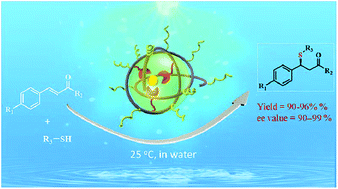Iron(ii)-folded single-chain nanoparticles: a metalloenzyme mimicking sustainable catalyst for highly enantioselective sulfa-Michael addition in water†
Abstract
Metalloenzyme is a source of inspiration for chemists who attempt to create versatile synthetic catalysts for aqueous catalysis. Herein, we impart metalloenzyme-like characteristics to a chiral FeII–oxazoline complex by incorporating an Fe(II) ion into a chiral oxazoline-containing discrete self-folded polymer, to realize highly enantioselective sulfa-Michael addition (SMA) in water. Intrachain FeII–oxazoline complexation together with hydrophobic interactions triggers the self-folding of the oxazoline-containing single polymeric chain in water. The formed FeII-folded single-chain polymeric nanoparticles (SCPNs) significantly accelerate the aqueous asymmetric SMA reaction via a self-folded hydrophobic compartment around the catalytic sites, reminiscent of metalloenzymatic catalysis. In addition, they can be facilely recovered for reuse by simple thermo-controlled separation due to their thermo-responsive properties. Such metallo-folded SCPNs combine the benefits of transition metal- and bio-catalyst, and avoid the tedious procedures of separation, which is a benefit for energy-saving and industrial applications.



 Please wait while we load your content...
Please wait while we load your content...